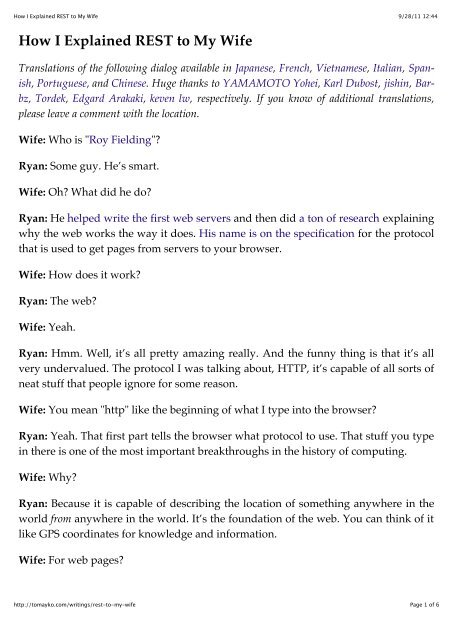How I Explained REST to My Wife
How I Explained REST to My Wife
How I Explained REST to My Wife
- No tags were found...
Create successful ePaper yourself
Turn your PDF publications into a flip-book with our unique Google optimized e-Paper software.
<strong>How</strong> I <strong>Explained</strong> <strong>REST</strong> <strong>to</strong> <strong>My</strong> <strong>Wife</strong>9/28/11 12:44<strong>How</strong> I <strong>Explained</strong> <strong>REST</strong> <strong>to</strong> <strong>My</strong> <strong>Wife</strong>Translations of the following dialog available in Japanese, French, Vietnamese, Italian, Spanish,Portuguese, and Chinese. Huge thanks <strong>to</strong> YAMAMOTO Yohei, Karl Dubost, jishin, Barbz,Tordek, Edgard Arakaki, keven lw, respectively. If you know of additional translations,please leave a comment with the location.<strong>Wife</strong>: Who is "Roy Fielding"?Ryan: Some guy. He’s smart.<strong>Wife</strong>: Oh? What did he do?Ryan: He helped write the first web servers and then did a <strong>to</strong>n of research explainingwhy the web works the way it does. His name is on the specification for the pro<strong>to</strong>colthat is used <strong>to</strong> get pages from servers <strong>to</strong> your browser.<strong>Wife</strong>: <strong>How</strong> does it work?Ryan: The web?<strong>Wife</strong>: Yeah.Ryan: Hmm. Well, it’s all pretty amazing really. And the funny thing is that it’s allvery undervalued. The pro<strong>to</strong>col I was talking about, HTTP, it’s capable of all sorts ofneat stuff that people ignore for some reason.<strong>Wife</strong>: You mean "http" like the beginning of what I type in<strong>to</strong> the browser?Ryan: Yeah. That first part tells the browser what pro<strong>to</strong>col <strong>to</strong> use. That stuff you typein there is one of the most important breakthroughs in the his<strong>to</strong>ry of computing.<strong>Wife</strong>: Why?Ryan: Because it is capable of describing the location of something anywhere in theworld from anywhere in the world. It’s the foundation of the web. You can think of itlike GPS coordinates for knowledge and information.<strong>Wife</strong>: For web pages?http://<strong>to</strong>mayko.com/writings/rest-<strong>to</strong>-my-wifePage 1 of 6
<strong>How</strong> I <strong>Explained</strong> <strong>REST</strong> <strong>to</strong> <strong>My</strong> <strong>Wife</strong>9/28/11 12:44Ryan: For anything really. That guy, Roy Fielding, he talks a lot about what thosethings point <strong>to</strong> in that research I was talking about. The web is built on an architecturalstyle called "<strong>REST</strong>". <strong>REST</strong> provides a definition of a "resource", which is whatthose things point <strong>to</strong>.<strong>Wife</strong>: A web page is a resource?Ryan: Kind of. A web page is a "representation" of a resource. Resources are justconcepts. URLs—those things that you type in<strong>to</strong> the browser…<strong>Wife</strong>: I know what a URL is..Ryan: Oh, right. Those tell the browser that there’s a concept somewhere. A browsercan then go ask for a specific representation of the concept. Specifically, the browserasks for the web page representation of the concept.<strong>Wife</strong>: What other kinds of representations are there?Ryan: Actually, representations is one of these things that doesn’t get used a lot. Inmost cases, a resource has only a single representation. But we’re hoping that representationswill be used more in the future because there’s a bunch of new formatspopping up all over the place.<strong>Wife</strong>: Like what?Ryan: Hmm. Well, there’s this concept that people are calling "Web Services". Itmeans a lot of different things <strong>to</strong> a lot of different people but the basic concept is thatmachines could use the web just like people do.<strong>Wife</strong>: Is this another robot thing?Ryan: No, not really. I don’t mean that machines will be sitting down at the desk andbrowsing the web. But computers can use those same pro<strong>to</strong>cols <strong>to</strong> send messagesback and forth <strong>to</strong> each other. We’ve been doing that for a long time but none of thetechniques we use <strong>to</strong>day work well when you need <strong>to</strong> be able <strong>to</strong> talk <strong>to</strong> all of the machinesin the entire world.<strong>Wife</strong>: Why not?Ryan: Because they weren’t designed <strong>to</strong> be used like that. When Fielding and hishttp://<strong>to</strong>mayko.com/writings/rest-<strong>to</strong>-my-wifePage 2 of 6
<strong>How</strong> I <strong>Explained</strong> <strong>REST</strong> <strong>to</strong> <strong>My</strong> <strong>Wife</strong>9/28/11 12:44Ryan: So anyway, HTTP—this pro<strong>to</strong>col Fielding and his friends created—is all aboutapplying verbs <strong>to</strong> nouns. For instance, when you go <strong>to</strong> a web page, the browser doesan HTTP GET on the URL you type in and back comes a web page.Web pages usually have images, right? Those are separate resources. The web pagejust specifies the URLs <strong>to</strong> the images and the browser goes and does more HTTPGETs on them until all the resources are obtained and the web page is displayed. Butthe important thing here is that very different kinds of nouns can be treated the same.Whether the noun is an image, text, video, an mp3, a slideshow, whatever. I can GETall of those things the same way given a URL.<strong>Wife</strong>: Sounds like GET is a pretty important verb.Ryan: It is. Especially when you’re using a web browser because browsers prettymuch just GET stuff. They don’t do a lot of other types of interaction with resources.This is a problem because it has led many people <strong>to</strong> assume that HTTP is just forGETing. But HTTP is actually a general purpose pro<strong>to</strong>col for applying verbs <strong>to</strong> nouns.<strong>Wife</strong>: Cool. But I still don’t see how this changes anything. What kinds of nouns andverbs do you want?Ryan: Well the nouns are there but not in the right format.Think about when you’re browsing around amazon.com looking for things <strong>to</strong> buy mefor Christmas. Imagine each of the products as being nouns. Now, if they were availablein a representation that a machine could understand, you could do a lot of neatthings.<strong>Wife</strong>: Why can’t a machine understand a normal web page?Ryan: Because web pages are designed <strong>to</strong> be unders<strong>to</strong>od by people. A machinedoesn’t care about layout and styling. Machines basically just need the data. Ideally,every URL would have a human readable and a machine readable representation.When a machine GETs the resource, it will ask for the machine readable one. When abrowser GETs a resource for a human, it will ask for the human readable one.<strong>Wife</strong>: So people would have <strong>to</strong> make machine formats for all their pages?Ryan: If it were valuable.http://<strong>to</strong>mayko.com/writings/rest-<strong>to</strong>-my-wifePage 5 of 6





